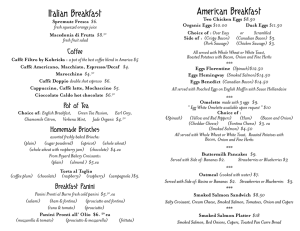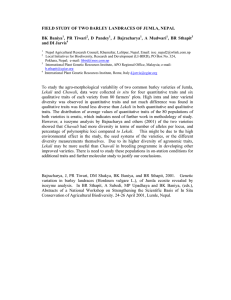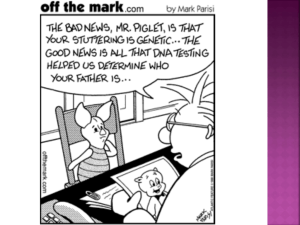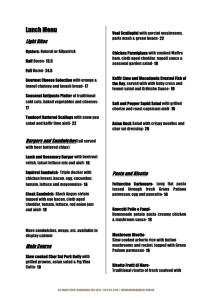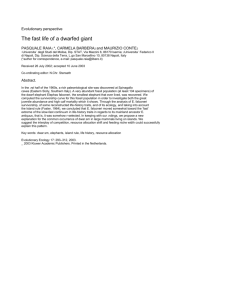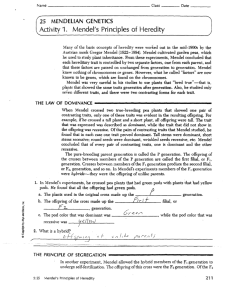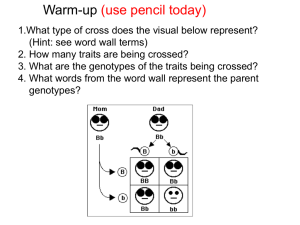Table A. List of sources used for the meta
advertisement
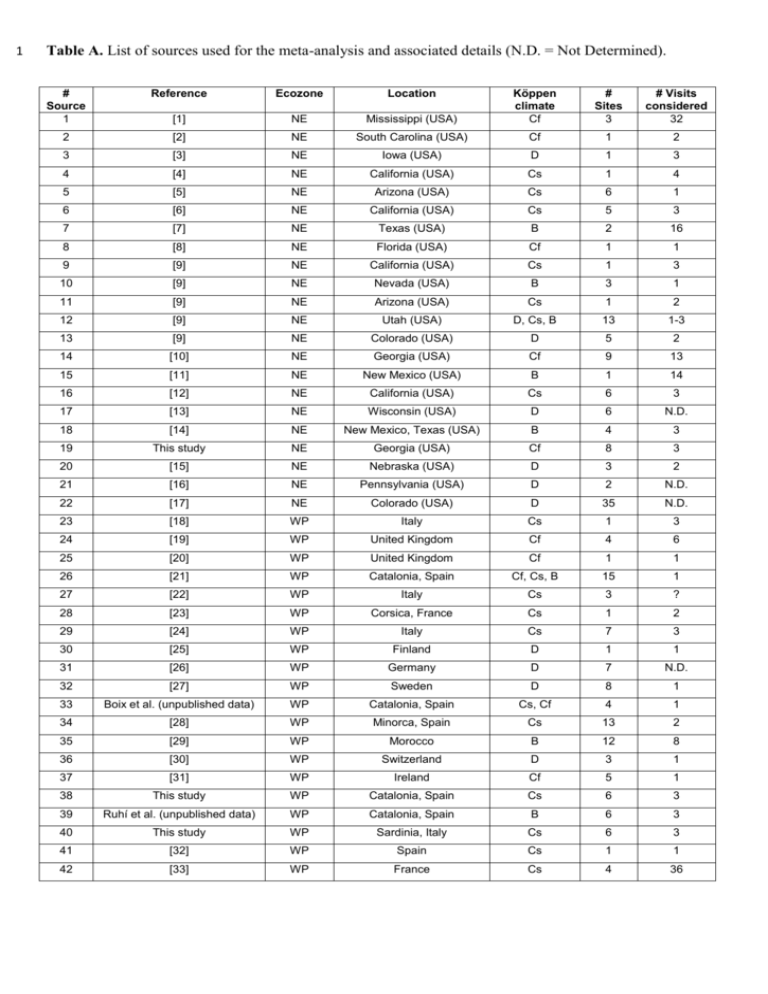
1 Table A. List of sources used for the meta-analysis and associated details (N.D. = Not Determined). # Source 1 Reference Ecozone Location Mississippi (USA) Köppen climate Cf # Sites 3 # Visits considered 32 [1] NE 2 [2] NE South Carolina (USA) Cf 1 2 3 [3] NE Iowa (USA) D 1 3 4 [4] NE California (USA) Cs 1 4 5 [5] NE Arizona (USA) Cs 6 1 6 [6] NE California (USA) Cs 5 3 7 [7] NE Texas (USA) B 2 16 8 [8] NE Florida (USA) Cf 1 1 9 [9] NE California (USA) Cs 1 3 10 [9] NE Nevada (USA) B 3 1 11 [9] NE Arizona (USA) Cs 1 2 12 [9] NE Utah (USA) D, Cs, B 13 1-3 13 [9] NE Colorado (USA) D 5 2 14 [10] NE Georgia (USA) Cf 9 13 15 [11] NE New Mexico (USA) B 1 14 16 [12] NE California (USA) Cs 6 3 17 [13] NE Wisconsin (USA) D 6 N.D. 18 [14] NE New Mexico, Texas (USA) B 4 3 19 This study NE Georgia (USA) Cf 8 3 20 [15] NE Nebraska (USA) D 3 2 21 [16] NE Pennsylvania (USA) D 2 N.D. 22 [17] NE Colorado (USA) D 35 N.D. 23 [18] WP Italy Cs 1 3 24 [19] WP United Kingdom Cf 4 6 25 [20] WP United Kingdom Cf 1 1 26 [21] WP Catalonia, Spain Cf, Cs, B 15 1 27 [22] WP Italy Cs 3 ? 28 [23] WP Corsica, France Cs 1 2 29 [24] WP Italy Cs 7 3 30 [25] WP Finland D 1 1 31 [26] WP Germany D 7 N.D. 32 [27] WP Sweden D 8 1 33 Boix et al. (unpublished data) WP Catalonia, Spain Cs, Cf 4 1 34 [28] WP Minorca, Spain Cs 13 2 35 [29] WP Morocco B 12 8 36 [30] WP Switzerland D 3 1 37 [31] WP Ireland Cf 5 1 38 This study WP Catalonia, Spain Cs 6 3 39 Ruhí et al. (unpublished data) WP Catalonia, Spain B 6 3 40 This study WP Sardinia, Italy Cs 6 3 41 [32] WP Spain Cs 1 1 42 [33] WP France Cs 4 36 2 Table B. Details of the procedure followed to merge the categories and biological traits of the selected data bases [34,35]. The 52 biological 3 traits (bolded) are those considered in the trait matrix. Category Biological trait Considered traits from EPA [34] > 16 mm Category and trait merging procedure 9-16 mm < 9 mm No traits eliminated in this category. Gills Considered traits from Tachet et al. [35] 2-4 cm >4-8 cm >8 cm 1-2 cm ≤.25 cm >.25-.5 cm >.5-1 cm Gills Body size Large Gills Merging of Respiration [35] and Resp [34] categories. Plastron, Spiracle Plastron Spiracle Plastron and spiracle “Hydrostatic vesicle” trait eliminated from Tachet et al. [35]. Tegument Tegument Tegument Eggs, free Eggs, cemented Clutches, cemented or fixed Clutches, free Isolated eggs, free Isolated eggs, cemented Clutches, cemented or fixed Eggs_cement > “No” + Eggs > “Eggs_single” Eggs_cement > “Yes” + Eggs > “Eggs_single” Eggs_cement > “Yes” + Eggs > “Eggs_1mass,” “Eggs_multiple_batch” Clutches, free Clutches, in vegetation Clutches, in vegetation Clutches, terrestrial Clutches, terrestrial Eggs_cement > “Yes” + Eggs > “Eggs_1mass”, “Eggs_multiple_batch” Ovipos_behav > “Algal mats”, “In moss/macrophytes (submerged)”, “In wet wood” + Eggs > “Eggs_1mass”, “Eggs_multiple_batch” Ovipos_behav > “Overhanging substrate (dry)” + Eggs > “Eggs_1mass”, “Eggs_multiple_batch” Medium Small Respiration Reproduction 4 Merging of Maximal potential size [35] and Max_body_size [34] categories. Merging of Reproduction [35] with Ovipos_behav_prim, Ovipos_behav_sec, Eggs_cement, Eggs_single, Eggs_1mass, and Eggs_multiple_batch [34] categories. In EPA [34], merging of “primary” and “secondary” strategies for each trait, and elimination of “other”, and Ovipos_behav “Bank soil”, “Bottom sediments”, “Floating debris”, “Free-floating”, “On/under stones (submerged)” traits. “Ovoviviparity” and “Asexual reproduction” traits eliminated in Tachet et al. [35]. 5 (cont.) Category Biological trait Feeding mode Habitat Microhabitat 6 Considered traits from EPA [34] Collector-filterer Category and trait merging procedure Filter-feeder Considered traits from Tachet et al. [35] Filter-feeder Collector Deposit feeder Collector-gatherer In EPA [34], merging of “primary” and “secondary” strategies for each trait, and elimination of “other”. Scraper Scraper Herbivore (scraper) Shredder Piercer Predator Parasite Shredder Piercer Predator Parasite Scraper/grazer Shredder Piercer herbivore Predator Parasite Attached/fixed Burrower Skater Swimmer Interstitial Other Temporarily attached, permanently attached Burrower Surface swimmer Full water swimmer Interstitial Crawler Flags/boulders/ cobbles/pebbles Gravel Sand Silt Macrophytes Microphytes Flags/boulders/ cobbles/pebbles Gravel Sand Silt Macrophytes Microphytes Detritus/litter Organic detritus/litter Attached/fixed Burrower Skater Swimmer Sprawler Other (Climber,clinger, crawler) Rocks Boulder Gravel Sand Silt Plants Phyto Algae LWD (large woody debris) Detritus Merging of Feeding Habits [35] with Feed_prim_abbrev and Feed_mode_sec [34] categories. Merging of Locomotion and substrate relation [35] with Habit_prim and Habit_sec [34] categories. In EPA [34], merging of “primary” and “secondary” strategies for each trait, and elimination of “planktonic” and “diver” traits. In Tachet et al. [35], elimination of “flier” trait. Merging of Substrate (preferendum) [35] with Microhab [34] categories. In EPA [34], elimination of “pelagic” trait; in Tachet et al. [35], elimination of “twigs/roots” and “mud” traits. 7 (cont.) Category Biological trait Exit temporarily Absent Number of aquatic stages Voltinism Trophic preferendum 8 Considered traits from Tachet et al. [35] Aquatic passive Aerial passive Considered traits from EPA [34] Absent Category and trait merging procedure Present Aerial active Present 1 (larva/nymph only) 1 (larva/nymph only) 1 (larvae/nymph only) Merging of Aquatic stages [35] with Aquatic stages [34] categories. 2 (egg, larva/nymph) 3 (egg, larva/nymph, adult; or egg, larva, pupa) 4 (egg, larva, pupa, adult) 2 (egg, larva/nymph) 3 (egg, larva/nymph, adult; or egg, larva, pupa) 4 (egg, larva, pupa, adult) 2 (egg, larvae/nymph) 3 (egg, larva/nymph, adult; or egg, larva, pupa) No traits eliminated in this category. <1 <1 Semivoltine Merging of Potential number of cycles per year [35] with Voltinism [34] categories. 1 1 Univoltine No traits eliminated in this category. >1 >1 Bi_multivoltine Oligotrophic Oligotrophic O2 high Merging of Trophic status (preferendum) [35] with O2_high, O2_normal, and O2_low [34] categories. Mesotrophic Mesotrophic O2 normal No traits eliminated in this category. Eutrophic Eutrophic O2 low Merging of Dispersal [35] with Exit temporarily [34] categories. Elimination of “Aquatic active” trait in Tachet et al. [35]. 4 (egg, larva, pupa, adult 9 (cont.) Category Biological trait Considered traits from Tachet et al. [35] Considered traits from EPA [34] Category and trait merging procedure pH preferendum Acidic ≤4 > 4 - 4.5 pH_acidic Merging of pH (preferendum) [35] with pH_acidic, pH_normal, and pH_alkaline [34] categories. Normal > 4.5 – 5 5 - 5.5 pH_normal No traits eliminated in this category. Alkaline 5.5-6 >6 pH_alkaline Fresh waters Fresh water Salin_fresh Brackish waters Brackish water Salin_brackish Psychrophilic Psychrophilic Cold stenothermal Thermophilic Thermophilic Hot euthermal Eurythermic Eurythermic Cold-cool eurythermal Warm eurythermal Salinity preferendum Temperature preferendum 10 Merging of Salinity (preferendum) [35] with Salin [34] categories. “Salin_salt” trait was eliminated from EPA [34]. Merging of Temperature [35] with Thermal_pref [34] categories. “No strong preference” trait was eliminated from EPA [34]. 11 References Tables A & B in File S1 12 1. Bonner LA, Diehl WJ, Altig R (1997) Physical, chemical and biological dynamics of five 13 14 15 16 17 18 19 temporary dystrophic forest pools in Central Mississippi. Hydrobiologia 353: 77-89. 2. Braccia A, Batzer D (2001) Invertebrates associated with woody debris in a Southeastern U.S. forested floodplain wetland. Wetlands 21: 18-31. 3. Christensen J, Crumpton W (2010) Wetland invertebrate community responses to varying emergent litter in a prairie pothole emergent marsh. Wetlands 30: 1031-1043. 4. De Szalay FA, Resh VH (2000) Factors influencing macroinvertebrate colonization of seasonal wetlands: responses to emergent plant cover. Freshw Biol 45: 295-308. 20 5. Graham TB (2002) Survey of aquatic macroinvertebrates and amphibians at Wupatki National 21 Monument, Arizona, USA: An evaluation of selected factors affecting species richness in 22 ephemeral pools. Hydrobiologia 486: 215-224. 23 24 25 26 6. Marchetti MP, Garr M, Smith ANH (2010) Evaluating wetland restoration success using aquatic macroinvertebrate assemblages in the Sacramento Valley, California. Rest Ecol 18: 457-466. 7. Merickel FW, Wangberg JK (1981) Species composition and diversity of macroinvertebrates in two playa lakes on the Southern High Plains, Texas. Southwest Nat 26: 153-158. 27 8. Merritt RW, Higgins MJ, Cummins KW, Vandeneeden B (1999) The Kissimmee river–riparian 28 marsh ecosystem, Florida. In: Batzer DP, Rader RD, Wissinger SA, editors. Invertebrates in 29 freshwater wetlands of North America: ecology and management. New York: John Wiley 30 and Sons. pp. 55-79. 31 32 33 34 9. BLM/USU (pers. comm.) BLM/USU (US Bureau of Land Management/Utah State University) National Aquatic Monitoring Center, Logan, UT. 10. Reese EG, Batzer DP (2007) Do invertebrate communities in floodplains change predictably along a river's length? Freshw Biol 52: 226-239. 35 36 11. Richardson G, Ward CR, Huddleston EW (1972) Aquatic macroinvertebrates of the playa. Logan, UT: U.S. International Biological Program, Desert Biome. 30 p. 37 12. Rogers C (1998) Aquatic macroinvertebrate occurrences and population trends in constructed 38 and natural vernal pools in Folsom, California. In: Witham CW, Bauder ET, Belk D, Ferren 39 Jr. WR, Ornduff R, editors. Ecology, Conservation, and Management of Vernal Pool 40 Ecosystems – Proceedings from a 1996 Conference. Sacramento, CA: California Native Plant 41 Society. pp. 224-235. 42 43 44 45 46 47 13. Schneider DW, Frost TM (1996) Habitat duration and community structure in temporary ponds. J North Am Benthol Soc 15: 64-86. 14. Sublette JE, Sublette MS (1967) The limnology of playa lakes on the Llano Estacado, New Mexico and Texas. Southwest Nat 12: 369-406. 15. Whiles M, Goldowitz B (2005) Macroinvertebrate communities in central Platte River wetlands: Patterns across a hydrologic gradient. Wetlands 25: 462-472. 48 16. Wissinger SA, Gallagher LJ (1999) Beaver pond wetlands in Northwestern Pennsylvania. Modes 49 of colonization and sucesssion after drought. In: Batzer DP, Rader RD, Wissinger SA, 50 editors. Invertebrates in freshwater wetlands of North America: ecology and management. 51 New York: John Wiley and Sons. pp. 333-362. 52 17. Wissinger SA, Bohonak AJ, Whiteman HH, Brown WS (1999) Subalpine wetlands in Colorado. 53 Habitat permanence, salamander predation, and invertebrate communities. In: Batzer DP, 54 Rader RD, Wissinger SA, editors. Invertebrates in freshwater wetlands of North America: 55 ecology and management. New York: John Wiley and Sons. pp. 757-790. 56 18. Bazzanti M, Baldoni S, Seminara M (1996) Invertebrate macrofauna of a temporary pond in 57 Central Italy: composition, community parameters and temporal succession. Archiv 58 Hydrobiol 137: 77-94. 59 60 19. Bevercombe A, Cox N, Thomas M, Young J (1973) Studies of the invertebrate fauna of a wet slack in a sand dune system. Archiv Hydrobiol 71: 487-516. 61 20. Blackstock TH, Duigan CA, Stevens DP, Yeo MJM (1993) Case studies and reviews. Vegetation 62 zonation and invertebrate fauna in Pant–y–llyn, an unusual seasonal lake in South Wales, 63 UK. Aquat Conserv: Mar Freshwat Ecosyst 3: 253-268. 64 21. Boix D, Gascón S, Sala J, Badosa A, Brucet S, et al. (2008) Patterns of composition and species 65 richness of crustaceans and aquatic insects along environmental gradients in Mediterranean 66 water bodies. Hydrobiologia 597: 53-69. 67 22. Cianficconi F, Moretti G, Pirisinu Q, Tucciarelli F (1976) Composizione sistematica delle 68 comunità acquatiche del settore meridionale dei Monti Sibillini, con considerazioni 69 zoogeografiche. Lav Soc It Biogeogr 6: 479-524. 70 71 23. Culioli J, Foata J, Mori C, Orsini A, Marchand B (2006) Temporal succession of the macroinvertebrate fauna in a Corsican temporary pond. Vie et milieu 56: 215-221. 72 24. Della Bella V (2005) Composizione tassonomica, organizzazione funzionale e struttura in taglia 73 della macrofauna a invertebrati di biotopi temporanei e permanenti del litorale tirrenico. 74 Roma: Università di Roma "La Sapienza". 150 p. 75 76 77 78 79 80 25. Hirvenoja M (2002) The fauna in two cold springs and in an epirhithral pool in southern Finland. Sahlbergia 7: 7-25. 26. Kramer H (1964) Okologische untersuchungen an temporaren tumpeln des bonner kottenforstes. Decheniana 117: 53-132. 27. Liungman M (2008) Linsräka i Stockholms län. En inventering av bottenfauna i efemära vatten på nio platser i Stockholms län 2007. Stockholm: Länsstyrelsens I Stockholms län. 39 p. 81 28. Boix D, Ruhí A, Sala J, Gascón S, Compte J, et al. (2009) Aportació al coneixement de les 82 associacions de macrofauna de les basses temporanies de Menorca. Projecte Life Basses, 83 Life05/Nat/ES/000058. Maó: Consell Insular de Menorca. 21 p. 84 29. Metge G (1986) Etude des écosystèmes hydromorphes (daya, merja) de la Méséta occidentale 85 marocaine: typologie et synthèse cartographique à objectif sanitaire appliquée aux 86 populations d'Anopheles labranchiae (Falleroni, 1926), (Diptera, Culicidae, Anophelinae). 87 Aix-en-Provence: Université de Droit, d’Economie et Sciences d’Aix-Marseille. 280 p. 88 30. Oertli B, Indermuehle N, Angélibert S, Hinden H, Stoll A (2008) Macroinvertebrate assemblages 89 in 25 high alpine ponds of the Swiss National Park (Cirque of Macun) and relation to 90 environmental variables. Hydrobiologia 597: 29-41. 91 31. Porst G, Irvine K (2009) Distinctiveness of macroinvertebrate communities in turloughs 92 (temporary ponds) and their response to environmental variables. Aquat Conserv: Mar 93 Freshwat Ecosyst 19: 456-465. 94 32. Sahuquillo M, Poquet J, Rueda J, Miracle M (2007) Macroinvertebrate communities in sediment 95 and plants in coastal Mediterranean water bodies (Central Iberian Peninsula). Ann Limnol – 96 Int J Lim 43: 117-130. 97 33. Terzian E (1979) Ecologie des mares temporaires de l'Isoetion dans la Crau et l'Esterel (France). 98 Aix-en-Provence: Université de Droit, d’Economie et Sciences d’Aix-Marseille. 210 p. 99 34. U.S. EPA. (2012) Freshwater Biological Traits Database. Washington, DC: United States 100 Environmental 101 Accessed 1 December 2012. 102 103 Protection Agency. Available: http://www.epa.gov/ncea/global/traits/. 35. Tachet H, Richoux P, Bournaud M, Usseglio–Polatera P (2002) Invertebrés d’eau douce (2nd corrected impression). Paris: CNRS éditions. 587 p.
